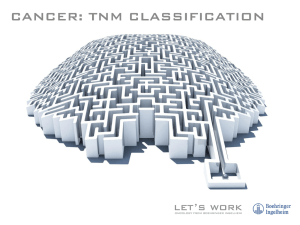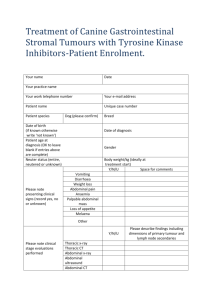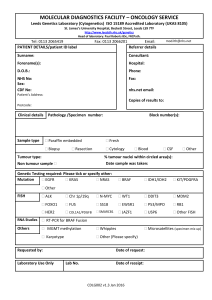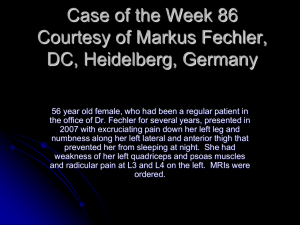THE IMPORTANCE OF STAGING
advertisement
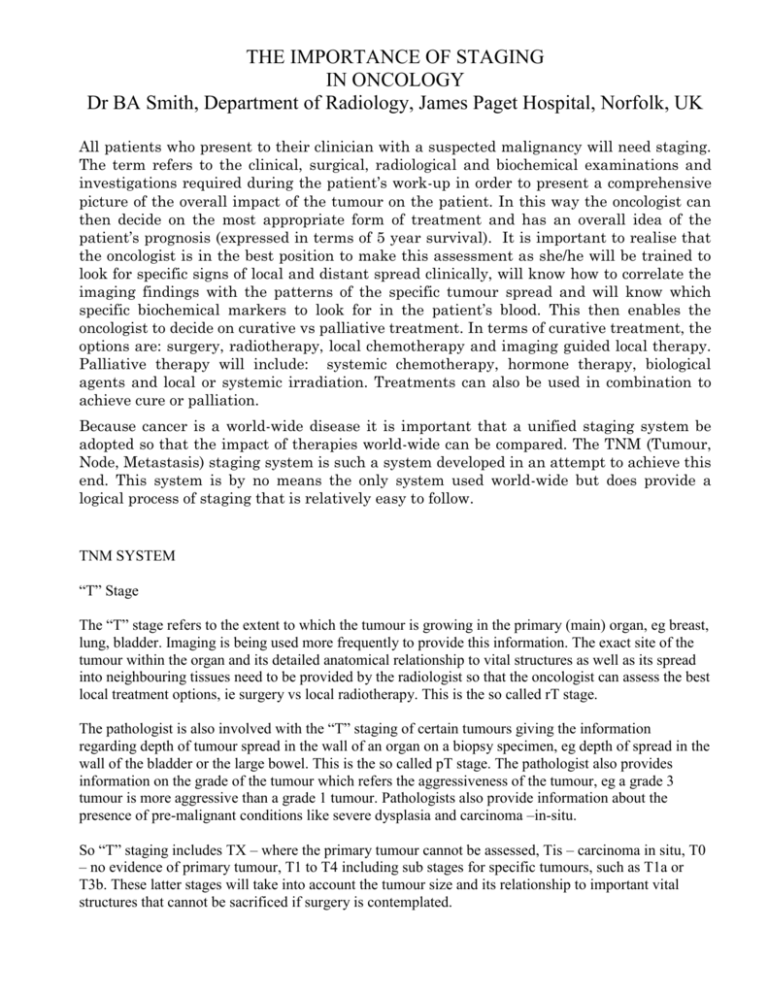
THE IMPORTANCE OF STAGING IN ONCOLOGY Dr BA Smith, Department of Radiology, James Paget Hospital, Norfolk, UK All patients who present to their clinician with a suspected malignancy will need staging. The term refers to the clinical, surgical, radiological and biochemical examinations and investigations required during the patient’s work-up in order to present a comprehensive picture of the overall impact of the tumour on the patient. In this way the oncologist can then decide on the most appropriate form of treatment and has an overall idea of the patient’s prognosis (expressed in terms of 5 year survival). It is important to realise that the oncologist is in the best position to make this assessment as she/he will be trained to look for specific signs of local and distant spread clinically, will know how to correlate the imaging findings with the patterns of the specific tumour spread and will know which specific biochemical markers to look for in the patient’s blood. This then enables the oncologist to decide on curative vs palliative treatment. In terms of curative treatment, the options are: surgery, radiotherapy, local chemotherapy and imaging guided local therapy. Palliative therapy will include: systemic chemotherapy, hormone therapy, biological agents and local or systemic irradiation. Treatments can also be used in combination to achieve cure or palliation. Because cancer is a world-wide disease it is important that a unified staging system be adopted so that the impact of therapies world-wide can be compared. The TNM (Tumour, Node, Metastasis) staging system is such a system developed in an attempt to achieve this end. This system is by no means the only system used world-wide but does provide a logical process of staging that is relatively easy to follow. TNM SYSTEM “T” Stage The “T” stage refers to the extent to which the tumour is growing in the primary (main) organ, eg breast, lung, bladder. Imaging is being used more frequently to provide this information. The exact site of the tumour within the organ and its detailed anatomical relationship to vital structures as well as its spread into neighbouring tissues need to be provided by the radiologist so that the oncologist can assess the best local treatment options, ie surgery vs local radiotherapy. This is the so called rT stage. The pathologist is also involved with the “T” staging of certain tumours giving the information regarding depth of tumour spread in the wall of an organ on a biopsy specimen, eg depth of spread in the wall of the bladder or the large bowel. This is the so called pT stage. The pathologist also provides information on the grade of the tumour which refers the aggressiveness of the tumour, eg a grade 3 tumour is more aggressive than a grade 1 tumour. Pathologists also provide information about the presence of pre-malignant conditions like severe dysplasia and carcinoma –in-situ. So “T” staging includes TX – where the primary tumour cannot be assessed, Tis – carcinoma in situ, T0 – no evidence of primary tumour, T1 to T4 including sub stages for specific tumours, such as T1a or T3b. These latter stages will take into account the tumour size and its relationship to important vital structures that cannot be sacrificed if surgery is contemplated. TABLE 1 : This is an example of the “T” and “N” stages for Breast Cancer “N” Stage All tumours have the potential for spread. This is achieved by local growth (continuity and contiguity), lymphatic and haematogenous (blood) spread. Lymphatic spread usually takes place in an ordered way, ie to local and regional lymph nodes and then to more central nodal stations. This is not always the case. The most accurate information about nodal spread is provided by the histopathologist either by nodal examination obtained from a surgical specimen or from an imaging guided cytological or histological biopsy. Clinical examination for enlarged peripheral nodes is less reliable and depends on the site of the enlarged nodes and some clinical features of the node. Supraclavicular, axillary, deep cervical and groin nodes are accessible to clinical examination. Some deep intracavity nodes are not clinically or surgically accessible and this is where imaging can detect these enlarged nodes and imaging guided techniques are used to obtain either cytology or histology for examination. Whilst imaging can detect the presence of enlarged local or distant nodes it has a limited sensitivity and specificity in predicting tumour spread in the enlarged nodes. The point is that imaging cannot reliably distinguish between enlarged lymph nodes that are reactive from those that have tumour within them. Similarly imaging cannot say whether a normal sized lymph node has microscopic disease or not. Unless there is evidence of nodal necrosis or nodal enhancement in a similar way to the primary tumour, size of the node has a specificity of 75 – 85% depending on the site of enlargement. Work is currently underway in the field of fusion imaging, eg combining computed tomography (CT) with positron emission tomography (PET) and in the field specific contrast enhanced imaging, eg MRI with the addition of ultra-small iron oxide particles, in an attempt to improve sensitivity and specificity for tumour detection within lymph nodes. Nodal staging therefore includes NX-where nodal status cannot be assessed, N0- where regional nodes are not involved, to N1 to N2 where regional nodes are involved ( depending on the number of regional nodes involved ). Obviously N3 and N4 disease means distant lymph node metastases that carry a worse prognosis. See table 1 for the “N” stage of breast cancer. TABLE 2 : “N” stage for non small cell lung cancer “M” Stage This stage is an indication of distant tumour spread either via the blood stream or via lymphatic spread to distant sites which are usually other specific organs dependent on the primary tumour. The main sites of distant spread include the liver, lungs and the bones (usually the axial skeleton but also long bones). Detection of distant spread is best achieved by cross-sectional imaging, mainly CT, which provides detailed information of the major solid organs, the lung and the axial skeleton. Nuclear medicine, MRI and ultrasound are other techniques that can be used in specific instances. Data collected over the past 30 years has shown that tumour spread to specific sites have a better prognosis than when it spreads to other organs. This has resulted in the introduction of a sub stage in metastasis spread. So “M” stage includes MX- distant spread cannot be assessed, M0 – no evidence of distant spread, M1 – evidence of distant spread with sub stages M1a and M1b, depending on where the tumour has spread to, eg M1a is spread to the lungs in soft tissue sarcomas. Where the patient has limited spread to a single organ, like lung or liver, surgical removal of these metastases is possible. TABLE 3 : “M” stage for Prostate cancer OTHER STAGING SYSTEMS The TNM system is by no means the only system used. There is the American Joint Committee on cancer staging system(AJCC) used as an alternative to the TNM system, the Federation Internationale de Gynecologie et d’Obstetrique (FIGO) system for gynaecological cancers and the modified Ann Arbor system for Hodgkin’s Disease. The TNM is a product of the cooperation of many cancer societies in an attempt to produce a unified workable international system. Recent co-operation between the many Cancer Societies have resulted in the publication of documents that often quote 2 staging systems side by side to guide the clinician. TABLE 4 : Combined TNM and FIGO staging systems of Ovarian Cancer PROGNOSIS Once the patient’s cancer has been confirmed clinically and a histological diagnosis of tumour type has been achieved, the tumour can then be staged using an internationally recognised system for that particular tumour type. This then provides the oncologist with the necessary information regarding primary treatment and prognosis expressed as a 5 year survival rate. Once the patient has had primary treatment, the patient may undergo further investigation to assess response to treatment, ie complete response, partial response, stable disease or disease progression. This information will be used by the oncologist to determine further treatment options or to submit the patient to a schedule of surveillance where the tumour has been completely removed/or disappeared following primary treatment. References 1. Clinical Practice Guidelines in Oncology v1.2003, National Comprehensive Network, for tables 1,2,3 and 4 2. Husband, Janet E and Reznek, Rodney H; Imaging in Oncology 2nd edition; Taylor and Francis 2004.
